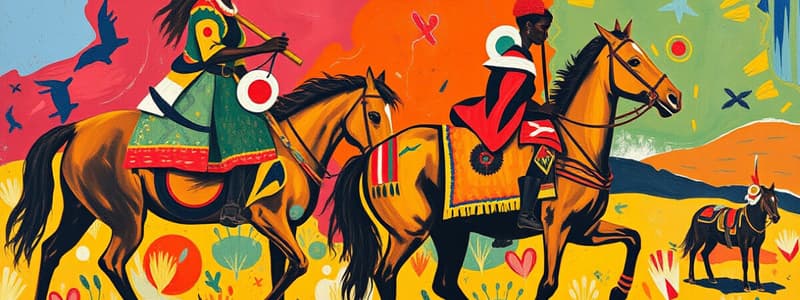Podcast
Questions and Answers
What was the primary outcome of the Cattle Killing movement among the Xhosa people?
What was the primary outcome of the Cattle Killing movement among the Xhosa people?
- Strengthening of traditional leadership structures
- Dependency on food aid provided by British officials (correct)
- A rise in available resources and cattle
- Increased autonomy from British governance
Which of the following figures represents the estimated number of Xhosa who died from famine as a result of the Cattle Killing?
Which of the following figures represents the estimated number of Xhosa who died from famine as a result of the Cattle Killing?
- 300,000 to 400,000
- 50,000
- 20,000 (correct)
- 30,000
How did the Cattle Killing movement affect the relationship between the Xhosa and the British?
How did the Cattle Killing movement affect the relationship between the Xhosa and the British?
- It became more contentious than before.
- Xhosa began to challenge British governance more aggressively.
- It shifted from conflict to dependency on British aid. (correct)
- There was no significant change in their relationship.
What did the prophecy associated with the Cattle Killing call for?
What did the prophecy associated with the Cattle Killing call for?
Which factor contributed to the acceptance of British governance among certain factions of the Xhosa?
Which factor contributed to the acceptance of British governance among certain factions of the Xhosa?
What was the main reason for the competition between Dutch farmers and Xhosa chiefdoms?
What was the main reason for the competition between Dutch farmers and Xhosa chiefdoms?
What was the outcome of the British attack on the Xhosa in 1811-12?
What was the outcome of the British attack on the Xhosa in 1811-12?
How many Frontier Wars did the Xhosa fight against the British by 1857?
How many Frontier Wars did the Xhosa fight against the British by 1857?
What sparked the Xhosa's last attempt to resist colonial control?
What sparked the Xhosa's last attempt to resist colonial control?
What was a common misconception among the Xhosa in response to Nongawuse's prophecy?
What was a common misconception among the Xhosa in response to Nongawuse's prophecy?
Which group of people joined the Xhosa during their 1850 uprising?
Which group of people joined the Xhosa during their 1850 uprising?
What event preceded the decline of the Xhosa nation in the late 1850s?
What event preceded the decline of the Xhosa nation in the late 1850s?
What were mission stations primarily established for?
What were mission stations primarily established for?
Flashcards are hidden until you start studying
Study Notes
Contact and Conflict
- Early interactions between Dutch farmers and Xhosa chiefdoms included both conflict and trade along the Eastern Cape frontier.
- Competition over grazing land primarily fueled tensions, as both groups were cattle farmers.
- Three Frontier Wars occurred prior to British control of the Cape.
Frontier Wars Overview
- Frontier Wars, also known as Xhosa Wars or Kaffir Wars, spanned from 1779 to 1879 between the Xhosa Kingdom and the British Empire, as well as Trekboers.
- Peaceful exchanges included trade and missionary activities, with Xhosa individuals often working on settler farms in exchange for goods like tobacco, copper, and iron.
British Intervention
- In response to land conflicts, the British government compelled the Xhosa to move east of the Fish River in 1811-12 through military action, capturing cattle in the process.
- Subsequent decades saw several more Frontier Wars, culminating in an Xhosa attack in 1850 to reclaim lost land.
The 1850 Revolt
- The Xhosa were reinforced by Khoi from mission stations and farm laborers fearing job losses due to shifts toward wool farming, which required less labor.
- Despite initial panic among settlers, British troops were deployed to suppress the revolt, maintaining arms and soldier supplies.
Cattle Killing Prophecy
- By 1857, the Xhosa faced significant challenges: eight Frontier Wars, drought, crop failure, and livestock losses.
- Nongawuse, a young Xhosa woman, claimed to have a vision promising restoration of power if the Xhosa killed their cattle and ceased planting crops.
- Following her prophecy, the Xhosa slaughtered 300,000 to 400,000 cattle, resulting in approximately 20,000 deaths from famine and 30,000 individuals seeking work on settler farms.
Impact of the Cattle Killing
- The Cattle Killing movement ultimately resulted in a broken resistance to colonial control among the Xhosa.
- The famine led to increased dependence on British food aid, reflecting a significant shift from conflict to reliance in the relationship.
- Traditional Xhosa leadership structures weakened as reliance on British support grew, leading to greater acceptance of British governance among certain factions in search of stability.
Studying That Suits You
Use AI to generate personalized quizzes and flashcards to suit your learning preferences.





